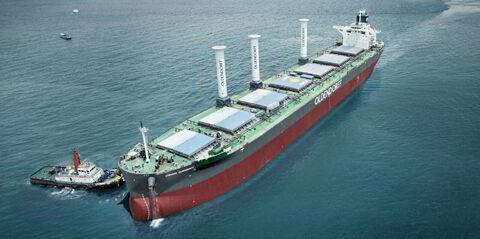A number of alternative fuels are being touted as the best way forward for low-emission ships, but Tristan Smith believes you don’t have to specify the fuel, just the goal.
“The IMO loves to talk about goal-based policy, and all you need to say is the goal is ‘this carbon intensity of fuel’ — just as they said it was ‘this sulphur content, but you can use a scrubber or very low-sulphur fuel oil’,” the decarbonisation expert says.
The IMO’s Carbon Intensity Indicator (CII) provides a goal-based framework that allows operators to slow vessels down or burn a green fuel. Either achieves the result of cutting emissions.
Green fuel choices come down to bio- or hydrogen-derived options, but the scalability and sustainability of biofuels are a challenge.
“We have real concerns about any hydrogen-derived fuel that has carbon in it, and methanol is that fuel. It has got a lot of hype recently, but it is a real challenge in the long run to see how it would be made other than as a biofuel, given that it is a compound with hydrogen, carbon and oxygen.
“There are lots of other alternatives which we think are likely to be much cheaper in the long run, of which ammonia is the most obvious at this point.”
Smith says green fuels are not just about shipping.
“What we are building globally is a hydrogen economy and an electric economy, and the two are very tightly coupled.
“The broad mantra for governments is: electrify everything that you can, and use hydrogen for anything that’s left over or if you can’t do anything else. Bioenergy is only there at the edge for assistance and is more critically needed for a number of other uses, including plastic substitutes and food.”
Ammonia’s advantages include that it is a known commodity that is easier to store than hydrogen. About 150m tonnes of ammonia are currently produced a year — a level that Smith says can be tripled reasonably easily using renewable energy in developing countries. As with the cost of oil, the price of transport would not be a problem.
However, there are still safety issues with ammonia, and there might be problems with emissions, such as ammonia slip or nitrous oxide, that arise from the combustion of ammonia. Fuel cells that chemically extract the energy from hydrogen or ammonia could solve this problem.
The cost of renewable energies has been falling fast and should continue to do so, cutting the price of alternative fuels over time.
“By end of this decade, we think we will need a few hundred billions [of dollars] dedicated to the fuel supply for shipping committed to be spent over the 2030s,” Smith says.
It sounds high, but $20bn has already been committed in just a few years.



